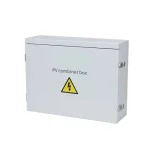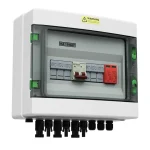A solar photovoltaic (PV) system is only as reliable as its weakest component. One critical element that often goes overlooked—but plays a major role in system safety and performance—is the PV combiner box. Whether you’re designing a residential rooftop array or a large-scale solar plant, choosing the correct combiner box is essential for smooth operation, effective protection, and long-term durability.
In this article, we’ll walk you through how to choose the right PV combiner box for your project. You’ll learn how to evaluate electrical ratings, select the appropriate enclosure type, understand protection requirements, and avoid common pitfalls. We’ll also include a practical case study to make the selection process easier to understand—and link you to a detailed guide on how to calculate the technical specs for your system.
What Is a PV Combiner Box?
A PV combiner box is an essential component in solar photovoltaic systems. It combines the output of multiple solar strings into a single DC output before connecting to the inverter. In addition to merging circuits, it typically includes protective components like:
String fuses
Surge protective devices (SPDs)
DC disconnect switches
Circuit breakers
Monitoring systems (optional)
PV combiner boxes are available in metal (iron) enclosures or non-metallic (plastic) enclosures:
Metal Enclosures: Known for high durability, impact resistance, and excellent heat dissipation. Suitable for harsh outdoor environments.
Plastic Enclosures: Lightweight, corrosion-resistant, and cost-effective. Best suited for residential or mild outdoor conditions.
Choosing the right type depends on environmental conditions, project size, and safety requirements.

Metal Enclosures PV Combiner Box

Plastic Enclosures PV Combiner Box
Why Choosing the Right Combiner Box Matters
Selecting an inappropriate combiner box can result in:
Overheating and equipment failure
Reduced energy efficiency
Difficulty in maintenance or upgrades
Safety hazards and code violations
The correct box ensures long-term stability, safety, and performance for your solar system.
Key Factors to Consider
1. System Voltage Rating
Your PV system may operate at 600V, 1000V, or 1500V DC. The combiner box must be rated to match or exceed this voltage.
2. Number of Strings
Count how many strings your array includes. Most boxes support 2 to 24 input strings. Choose one that can accommodate all strings or split into multiple boxes.
3. Input Current Per String
Each string’s current (Imp) determines the input fuse size. For example, a 550W panel with 13A Imp would need a 15A input fuse.
4. Output Current Rating
Total output current = string current × number of strings. Ensure the busbar and output protection device (breaker or disconnect) can handle this safely.
5. Protection Devices
A high-quality combiner box should include:
DC fuses or breakers on each input
SPD (DC surge protection)
DC disconnect switch (manual isolation)
Optional monitoring (string current, voltage, faults)
6. Installation Environment
Use IP65+ plastic or powder-coated metal enclosures for outdoor environments.
Consider temperature range, UV exposure, moisture, and dust levels.
7. Certifications and Standards
Make sure the box complies with relevant standards, such as:
IEC 61439
UL 1741 or UL 508A
CE marking
✅ Real-World Example: Choosing for a 55kW Rooftop Solar System
Let’s walk through a simplified case study to demonstrate how to choose a combiner box.
Scenario:
A client is installing a 55kW commercial rooftop solar system using 550W solar modules.
Module specs:
Voc: 49.5V
Imp: 13.25A
Step 1: Calculate Number of Panels
55,000W ÷ 550W = 100 panels
Step 2: Define Panels per String
Designing for a 1000V system with 80% safety factor:
1000V × 0.8 = 800V
800V ÷ 49.5V ≈ 16 panels per string
→ 100 ÷ 16 = 6.25 strings, round up to 7 strings
Step 3: Determine Input and Output Ratings
7 strings × 13.25A = 92.75A output current
Choose 15A input fuses
Use output breaker rated ≥ 100A
Final Selection:
✅ 7-in-1 PV combiner box, 1000V DC rated,
✅ 15A fuses × 7 inputs,
✅ 125A DC breaker with surge protection
💡 Need help calculating yours?
We’ve prepared a more detailed guide on how to calculate your system size and specs step by step:
👉 How to Calculate PV Combiner Box Specifications
Summary: How to Choose the Right PV Combiner Box
- ✅ Match your system voltage (600V / 1000V / 1500V)
- ✅ Calculate number of strings and current
- ✅ Choose proper inputprotection and SPD
- ✅ Select weatherproof enclosure material
- ✅ Ensure certification compliance
- ✅ Consider centralized vs. distributed string combining
Need a Recommendation?
Just send us your panel datasheet, inverter specs, and number of strings—we’ll help you select the most suitable model.
📩 Contact Us Now: info@derlicn.com
🔧 Custom Design Available
⚡ Fast Global Shipping
Table of Contents
Have you Any Questions?
Can’t find an answer to your question, or want more information about our products? If so, please feel free to get in touch with our professional team. We’re here to help you drive your projects to success.
